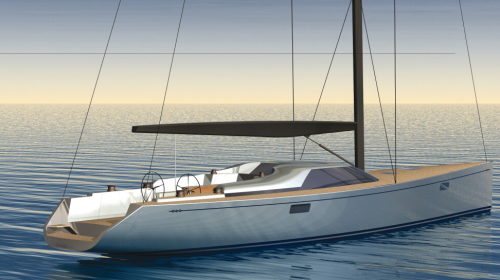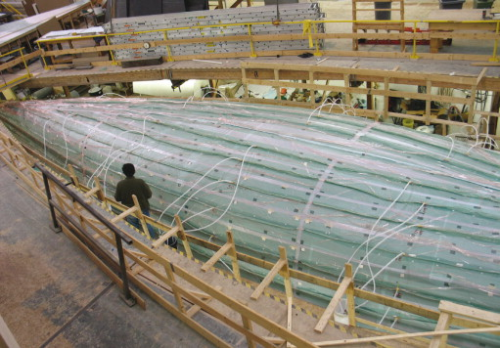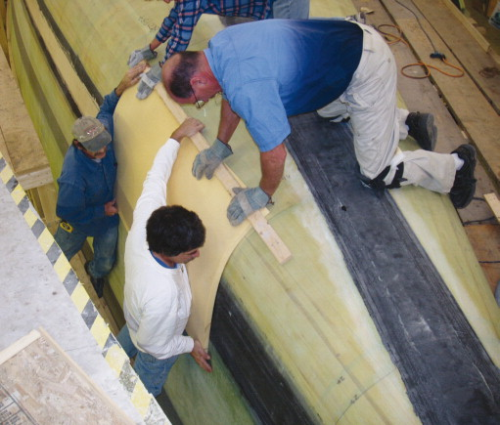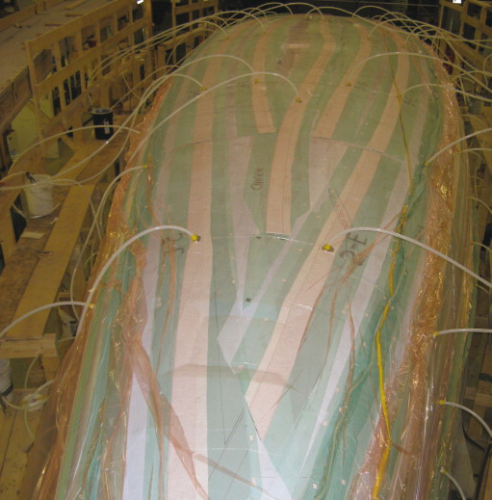



With a history that spans almost 200 years, five generations of Hodgdon boat builders have established
Hodgdon Yachts Incas the oldest family-owned boat builder in the USA. The shipyard has launched more than 400 vessels and has a reputation for building some of the finest composite yachts in the world using wood, carbon fibre and epoxy.
Based in East Boothbay, Maine, the company is currently run by the fifth generation Hodgdon. Tim Hodgdon took over the helm in 1979 and has overseen the build of many successful projects – including the technology demonstrator Mako for ONR (Office of Naval Research).
Hodgdon's latest offering is a stunning Bill Tripp designed 65’ Café Racer – a modern sailing yacht which demonstrates both uncompromising workmanship and exhilarating performance. The brief was simply to build the largest yacht two people can sail – which is increasingly being requested by many yacht owners in order to get away from the hassle and loss of privacy typical of crewed yachts.
Advancing composites construction
The Tripp-designed sloop is one demonstration of Hodgdon's diversification strategy. During the last 25 years it was building large, cold-moulded yachts. However in 2004 the company implemented a business plan to diversify, moving away from building one large project at a time, to undertaking multiple projects and advancing its composite construction methods.
Of course any successful boat build often depends on partnership and for the Tripp 65’ Café Racer, SP, the marine business of Gurit, was brought onboard to meet Hodgdon's requirements for quality and reliability, as well as offering expert technical support. This semi-custom lifting keel cruising yacht is unique in that it was built using Hodgdon's Cold-Moulded Composite Infusion (CMCI) process, which features a cold moulded inner structure backed up by a carbon fibre/epoxy sandwich laminate.
The construction of the yacht employed a male mould sheathed with Alaskan Yellow cedar. The inner laminate skin was infused to the mould, and the core material was heat formed and bonded to the inner skin. The outer laminate was then infused. Significant amounts of the cedar mould were left in place to reduce noise levels of the carbon composite structure and for cosmetic appearance.
Hodgdon chose SP's Prime 20LV epoxy infusion resin because of its low viscosity, ease of infusion and excellent physical properties, and its Core cell™ styrene acrylonitrile (SAN) core material for the construction of the yacht.
“We chose SP's Corecell SAN foam for many reasons,” says Ted Smith, a company representative from Hodgdon Yachts. “First, its small cell size means that less resin will be absorbed into the core, allowing for a more lightweight structure. Plus, the ability to thermoform Corecell allowed us to easily bend the foam sheets over the male hull shape without using cuts in the foam.”
Those ‘cuts’ would have meant extra cost, extra labour and most importantly, unnecessary weight in the hull structure from resin being taken up. Hodgdon chose to thermoform the core using a custom-built oven with heat sources supplied by Vulcan Catalytic in Rhode Island.
Hodgdon now uses a lot of thermoforming of Corecell for its projects and it is one of the big selling advantages of Corecell versus polyvinyl chloride (PVC) type foams.
Corecell and thermoforming
Corecell foam materials use an advanced SAN chemistry to provide increased performance for sandwich composite laminate manufacture. The core material is available in various thicknesses and can be provided with machined cut patterns (such as grooves) to assist in shaping and forming. These are designed to increase the flexibility of the material and allow it to be shaped, and also provide assistance in manufacture when using the material in processes such as resin infusion. However, in some cases these cut patterns are not desirable and in this case it is possible to use a technique called ‘thermoforming’ to shape the core to the required shape.
Thermoforming is a process of heating the core material to a point where the mechanical rigidity in the foam is temporarily broken down to a level which makes the core flexible, allowing it to be shaped and ‘formed.’ This temporary flexibility is reversed by the cooling of the foam where full mechanical properties are restored. This method of construction reduces the weight of the structure by removing any excess resin in cut patterns, and also allows a tighter and more accurate fit of the core. This leads to weight savings in core bonding and filling during the build process.
Thermoformed core demonstrates the exact mechanical properties indicated by the data sheet and product information. The addition of cuts and grooves to the foam materials can have large impacts on the mechanical properties which should be accounted for when designing and specifying using core materials in sandwich construction. As a result of the increased confidence in material properties once in situ, designers may be able to use more accurate figures, providing weight and mechanical benefits.
Partnership
The Tripp 65 is the first carbon composite sailing yacht built by Hodgdon Yachts and it is the third yacht to be built for the same client.
“This has enabled us to develop a successful relationship with yacht designer Bill Tripp Jr whilst allowing us to introduce a product line similar to our core business,” says Ted Smith. “We can therefore create smaller sailing yachts with many of the superyacht technologies and systems found in our larger yachts, whilst also introducing a style and size of yacht that implements our business goal of multiple projects.”
“We were delighted with the collaboration and skills that went into the vessel's design and manufacturing,” concludes Smith.






